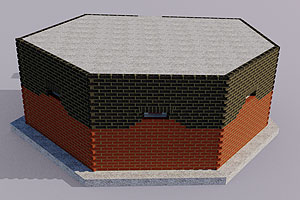Pillbox find at Southease Bridge
Posted: 11 October 2010 19:46
I recently went looking for the site of a Type 24 pillbox near Southease Bridge on the River Ouse between Newhaven and Lewes, and, much to my surprise, actually found it.
The old swing bridge at Southease is currently undergoing restoration, having been dismounted and laid out in sections on the east bank of the river, a temporary footbridge having been installed in the meantime. A Hamilton Bridge was erected in the vicinity by the Canadians in mid-1941 as a stronger alternative to the original; additional bridges may have followed later on in the war.
The photograph below shows the swing bridge before it was dismounted.

Even before these extra bridges, Southease Bridge was of strategic importance as a stop line crossing on the GHQ Line, and so a pillbox was sited alongside it on the western bank.
Until now there was only documentary evidence for this pillbox in the form of a red triangle on a German Befestingungskarte and confirmation of the location from a couple of postwar aerial photographs. I've Photoshopped the picture below to reinsert the pillbox back into the landscape.

A previous visit to this site had found nothing, although on that occasion I hadn't actively been searching for the site. The graphic above shows how close the pillbox would now be to the water's edge which is perhaps why I didn't think to venture that close to the river.
It was by chance then, that I stumbled upon the remnants seen below. What we have here are the foundations of the pillbox after it had been demolished down to ground level; the remains disappear at least two feet below ground. The remains comprise a concrete slab with evidence of brick shuttering and steel reinforcing rods.

It would appear that the pillbox was probably demolished not too long after the war, possibly during the 1950's. The reason for the removal of this and other pillboxes along this stretch of the river was probably related to their being dug into the river bank; documents regularly highlight the annoyance of local river authorities in regard to military activity that might affect drainage and flood defences.
The survival of this foundation opens the possibility that others may also still remain; a quick recce along the river unfortunately revealed no further evidence, but I'm more than happy with this find!
- Pete

Email:
Blog Latest

Bishopstone reveals its pillbox secrets
18 October 2021

Pillbox or Observation Post?
10 June 2020

Uncovering the hidden secrets of a pillbox
8 June 2019

Review of 2018
31 December 2018

Wartime Christmas in East Sussex (2)
24 December 2018
Jargon-buster
GHQ Line
A series of arterial stop lines designed to prevent German forces advancing on London and the industrial Midlands.
Pillbox
Generic term for a hardened field defensive structure usually constructed from concrete and/or masonry. Pillboxes were built in numerous types and variants depending on location and role.
Stop line
A physical continuous anti-tank barrier, normally a river and/or railway line, often defended by pillboxes. Stop line crossings (roads, railways and bridges) were to be made impassable.

Type 24 pillbox
A six-sided (but not a regular hexagon) pillbox. The Type 24 is the most frequently seen pillbox in East Sussex, mostly along stop lines. It can be found in thin wall (30cm) or thick wall (1m) variants.
This site is copyright © Peter Hibbs 2006 - 2024. All rights reserved.
Hibbs, Peter Pillbox find at Southease Bridge (2024) Available at: http://pillbox.org.uk/blog/216668/ Accessed: 27 July 2024
The information on this website is intended solely to describe the ongoing research activity of The Defence of East Sussex Project; it is not comprehensive or properly presented. It is therefore NOT suitable as a basis for producing derivative works or surveys!